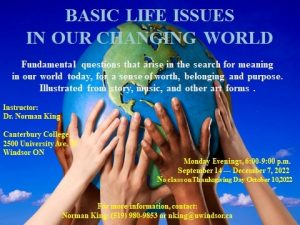Last week we mentioned that our life includes both joys and sorrows, winters and springs, darkness and light, storms and rainbows. It is important to acknowledge that our lives contain these contradictory experiences, and to try to name them truthfully. The challenge is to transform sadness and longing into beauty. With Leonard Cohen, whatever loneliness and brokenness we experience, it is always possible to sing Hallelujah. These may be the cracks where the light get in. Yet it certainly may take some working through, and the support of wisely caring others.
Richard Rohr reminds us, too, that any sorrow that is not transformed will be transmitted. It will be inflicted on others rather than entrusted to them.
This past week, I attended a presentation on grief which named and responded to some common cultural assumptions about grief that can have limiting and harmful effects. The presentation also brought out some creative ways to work through the grieving process rather than suggesting that we deny our real feelings or simply “get over it.”
I recall the words of a friend of Thomas Merton, spiritual writer, after Merton’s untimely, accidental death at the age of 53. The friend said that Merton’s death left a hole that would never be filled. To me, this remark says something about each person we come to know and love and who knows and loves us. Each one holds a unique place in our heart that no one else can occupy or replace. If we lose a copy of a book, it can be replaced. But if we have underlined that book and written notes in it, that particular copy becomes irreplaceable. The same is true of someone who has written words on our heart.
At t he same time, there is a process of transformation that can occur. In the early stages of grief, the memories we have may sting as we recall them. Later, they may be recalled with joy. On Thursday, I heard a fascinating talk and discussion with author, Lawrence Hill. He answered a question concerning the difficulty of writing about situations of suffering, cruelty, or injustice. He responded that, while it is difficult, these same characters also had counterbalancing experiences of joy and love and the like. He mentioned that the main character in The Book of Negroes is first introduced as an elderly woman. This portrayal indicates that she has endured and transcended any sorrows that have filled her life. As a result, these are held within a container of hope.
As our re-interpretation of the story of Pandora suggests, all the losses and sorrows of life are best held within a container of hope and love. This is the light that gets into the cracks of pain in our life. It is interesting that the sharing of bread involves its breaking. Our openness to the totality of life can include both the opening of our arms in a gesture of embrace. It can also be a process of breaking open that leaves us vulnerable yet ready to receive. As in The Selfish Giant, it may be through the cracks of vulnerability in our lives that new life can flow in and out.
There is a children’s story by Margaret Laurence, called The Olden Days Coat, which I find magical. In the story, ten-year-old Sal is disappointed when she and her parents spend Christmas at her grandmother’s house, instead of at her usual home, as they did before her grandfather died. In order to pass the time, Sal explores the contents of an old trunk. While searching through old photographs, she comes across a little girl’s winter coat, tries it on, and finds herself transported into the past. There she meets and makes a connection with her grandmother who shows her a box carved with a butterfly. This beautiful little box then becomes her present-day gift.
This story certainly reflects the unique connection between grandparents and grandchildren. It also suggests that gifts received continue to be shared over generations. Perhaps, more than anything, it shows how love, concretely expressed, may be transmitted across generations. Whenever anyone enters our heart, they remain there and become part of who we are. They are then shared with anyone who comes to share our heart. As in the story, however, it may take some time for us to realize this truth.
We spoke earlier of grieving. Perhaps the integration and transcending of grieving means that we allow our heart to be enlarged and opened by all who have entered in a caring way. We then share that legacy with all who in some way come to share our heart. In a somewhat similar way, writer of spirituality, Ron Rollheiser, says that we best remember those who have died by developing in ourselves their best qualities, even the simplest.
May you come to experience a heart open to all that is contained with the gift of life, and share it in a compassionate way with all those who in some way come within the circle of your light
Norman King, September 25, 2022
